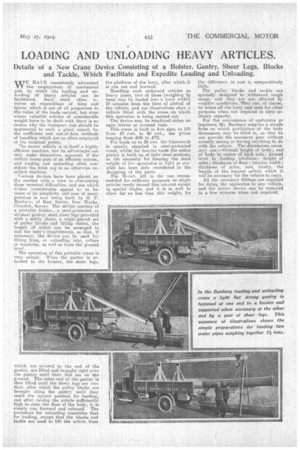LOADING AND UNLOADING HEAVY ARTICLES.
Page 9

If you've noticed an error in this article please click here to report it so we can fix it.
Details of a New Crane Device Consisting of a Bolster, Gantry, Sheer Legs, Blocks and Tackle, Which Facilitate and Expedite Loading and Unloading.
WE HAVE consistently advocated the employment of mechanical aids by which the loading and unloading of heavy articles can be facilitaied. SttUli work often involves an expenditure of time and labour which is out of all proportion to the value of the loads carried, but even where valuable articles of considerable weight have to be dealt with there is no reason why the transport, cost should be ailigrnented to such a great extent by the inefficient and out-of-date methods of handling which are so often employed at the terminal points.
The motor vehicle is in itself a highly efficient machine, but its advantages can only make themselves apparent if the vehicle forms part of an efficient system, and loading and unloading often constitute the weak cog in an otherwise excellent machine.
Various devices have been placed on the market with a view to overcoming these terminal difficulties, and one which Trakes considerable .appeal to us because of its simplicity and ease of manipulation is now being built by G. P. Banbury, of East Surrey Iron Works, Croydon, Surrey. The device consists of a portable bolster, a steel-protected or
gtutry, steel sheer legs provided with a safety Chain," a triple-geared set of pulley blocks and lifting chains, the lerrgth of which can be arranged to suit-the user's requirements., so that, if necessary, the device pan be used for lifting from, or unloading into, cellars or manholes, as well as from the ground
The operation of this portable crane is very simple. When the gantry is attached to the bolster, the sheer legs,
which are pivoted to the end of the gantry; are lifted and brought right over the gantry until their feet are on the ground. The outer end of the gantry is then lifted until the sheer legs are vertical, after which the pulley blocks are brought along the gantry until they reach the correct position for loading, and after raising the article auffiCiently high to clear the floor of the body, it is simply run forward and released. The procedure for 'unloading resembles that for loading, except that the blocks and tackle are used to lift the article from
the platform of the lorry, after which it is run out and lowered. "
Handling such awkward articles as heavy pipes, two of these (weighing 2i tons) may be loaded into a lorry within 10 minutes from the time of arrival of the vehicle, and our illustratiOns show a vehicle fitted with the crane on which this operation is being carried out.
The device may be employed either on open lorries or csavexed vans. This crane is built in five sizes to lift from 10 cwt. to 60 cwt., the prices ranging from &It to
For loads up to 30 cwt. the framework is usually supplied in steel-protected wood, whilst, for heavier loads the entire gantry is built up of light steel sections, as the necessity for keeping the dead weight of the apparatus a-s light as possible has been duly oonaidered in the designing of the parts.
The 30-cwt. lift is the one recommended for .ordinary purposes as single articles rarely exceed this amount except in special trades, and it is as well to allow for no leas than this weight, for the difference in costis comparatively little: The pulley blocks and 'tackle are specially designed to withstand rough usage, and they are not affected by weather conditions," They can, of course, be taken off the lorry and osed for other purposes when not required in their ordinary capacity.
For the convenience of customers or inquirers, Mr. Banbury supplies a. simple form on which particulars of the body dimensions may be filled in, so that he can provide the necessary gear without actually seeing or having anything to do with the vehicle. The dimensions necessary a4e.:—Overall length of body; end of body to centre of back axle; ground. level to loading platform.; height of sides; thickness of floor; interior width ; thickness of sides, and, finally, the length of the longest article which it will be necessary for the vehicle to carry. All the necessary fittings are supplied for fixing the apparatus to any vehicle, and the entire device can be removed in a few minutes when not required.






























